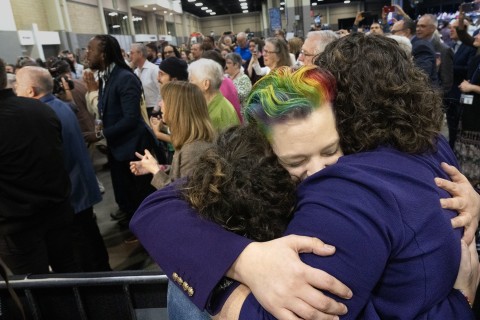Gathering for good
On a Copenhagen street, emergency responders and passersby formed a spontaneous community.

Copenhagen’s Børsen Stock Exchange before (2022) and after the devastating April 2024 fire. (Photos by Jakubhal / Penguin / W.carter /Jengod, used via Creative Commons license)
Five years and a day after Paris’s Notre-Dame cathedral burned, a fire broke out on the roof of Copenhagen’s 400-year-old stock exchange building, known to locals as Børsen. Emergency responders, office workers, and pedestrians watched in shock as flames spread through the iconic building. Firefighters battled the fire on the upper floors while officials on the ground started pulling historic artwork out of the building. As Børsen burned, journalists documented a fascinating development: passersby were running into the building to help save the paintings, antique furniture, and other artifacts.
These Good Samaritans weren’t art historians; they were ordinary commuters or people out for a walk. If someone had asked them beforehand what was worth risking their life for, they probably wouldn’t have named Peder Severin Krøyer’s 1895 oil painting From Copenhagen Stock Exchange. Yet when the moment arose, they decided it was worth the risk.
Read our latest issue or browse back issues.
Maybe they sensed that a culture is best embodied when its artifacts are regarded as shared possessions. Maybe their adrenaline was fed by the scene’s tangibility: the sound of crackling flames, the vivid colors splashed on canvases. Maybe they just saw six people lumbering under the weight of a massive painting and realized that a seventh could lighten the burden. For whatever reasons, these strangers spontaneously formed a transitory community around the idea of working toward a common good.
In this issue, theologian Brian Bantum explores the role of the church in the world. How does a church compare to a bicycle club, he wonders, or a public park or art museum? Where do we draw the line between insider and outsider, host and guest, stranger and kin? Can we share the goods we hold in common, so that the beauty we experience in worship might burst out and illuminate others?
Ultimately Bantum describes the work of the church as a collective endeavor, a transitory tending of the earth, “a point in time and space where our participation with God’s work in the world condenses, where bodies and souls gather into rich gray clouds just waiting to return what has been gathered.” That’s a generative image for Christians to ponder, whether we believe the church is a group of members who gather regularly around word and sacrament or we define the church simply as whoever happens to show up on a given day. For a brief period, we who gather—we who are gathered by God—condense into a cloud that’s ready to burst, just waiting to water the thirsty land.
Something similar happened at Børsen that April morning. For a stretch of time, the line between firefighter and ordinary citizen blurred and a living cloud of witnesses emerged. It wasn’t church, but it also wasn’t entirely unlike church. Nobody died in the fire, and some significant pieces of Denmark’s cultural history were preserved. It was a small victory but a palpable one. And then it dissipated: the bystanders went on with their days, the firefighters continued to extinguish the flames, the art historians took inventory of what had been saved. The land was a little less thirsty, and life went on.




